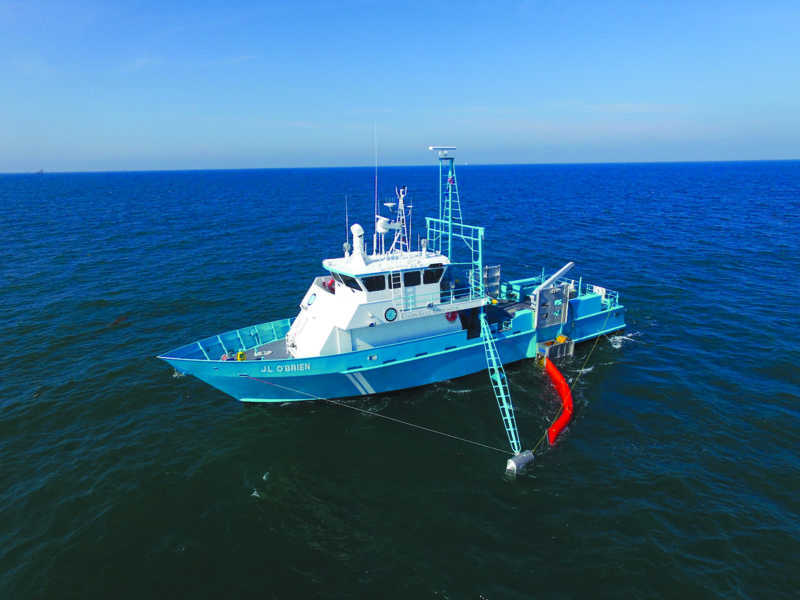After the Deepwater Horizon oil spill in the Gulf of Mexico in 2010, Clean Gulf Associates, a non-profit oil spill cooperative in New Orleans, significantly expanded its vessel fleet and oil spill support equipment inventory.
Clean Gulf had been relying on 47' near-shore oil spill response vessels (OSRVs) from Rozema Boat Works, but beginning in 2012, the company added four 95'x21' fast response boats and three 60'x14' shallow-water skimmers. All were built at Midship Marine in Harvey, La. “They were all state of the art,” said Frank Paskewich, president of Clean Gulf. The last 95 footer, the aluminum J.L. O’Brien, was delivered in 2017.
Even though Paskewich said Clean Gulf responds to “a handful” of incidents each year, the building of new boats has been put on hold. “We are not thinking of building. With the downturn in the oil industry, we’ve kind of been steady.”
That downturn means a dearth of funding for new OSRVs. “Their (Clean Gulf’s) funding got cut back with the oil industry being like it is,” said Randy Hinojosa, treasurer with Midship Marine. As a result, it’s been two years since Midship Marine has built an oil spill response vessel. The J.L. O’Brien was the last one built, which Hinojosa said was the first aluminum OSRV “of its kind to be built with overnight accommodations.”
Without outside funding, oil spill response companies won’t upgrade their fleets and boatyards will look elsewhere for work.
NEW OSRVs FOR CANADA
A good example of the power of funding is Western Canada Marine Response Corp. “WCMRC, they are on a roll,” said Paskewich. “They are the kings right now.”

The 74' Barkley Sentinel was launched in August for Western Canada Marine Response. Rozema Boat Works photo
WCMRC, a marine spill response organization on Canada’s West Coast based out of Burnaby, British Columbia, is “on a roll” because by 2022 oil should be flowing through a new pipeline, stretching from Alberta to the British Columbia coastline. Trans Mountain Corp., which is owned by the Canadian government, will operate the pipeline. Part of the approval process for the pipeline was a commitment “to provide additional capacity for spill response,” said Scott Wright, WCMRC’s director of response readiness. “It has definitely changed our business substantially.
WCMRC, originally named Burrard Clean Operations when it was established in 1976 with 25 employees, will have 200 employees by 2022. Their fleet of 44 OSRVs will double to 88 when the pipeline is operational. Additional boats will certainly be needed, as the increase in shipping will be substantial. Currently, four ships leave the Burnaby terminal a month. That number will increase to 34 ships. Then you have to factor in coverage of British Columbia’s extensive coastline, which is about 17,000 miles long. On average, WCMRC responds to 20 spills each year.
Rozema is a West Coast boatyard that’s already benefited from WCRMC’s fleet expansion. The Mount Vernon, Wash., boatyard has sent three 65'x23' aluminum skimmers north to WCMRC. Then in early August, the yard launched their first 74'x24' fast response skimmer, the Barkley Sentinel, for WCRMC. Another 74-footer is on order. (WCRM also obtained three 75-foot steel OSRVs from Singapore.)

The G.M. Penman was the first 65-footer Rozema Boat Works built for Western Canada Marine Response. Rozema Boat Works photo
The G.M. Penman, WCRMC’s first 65-footer, was built after WCMRC representatives took a ride in 2012 on a 65-footer that Rozema built for Clean Seas in Ventura, Calif. Rozema designed the 65' footers with a built-in skimming system. “I think we are the only ones on the West Coast that builds with built-in side skimmers,” said Dirk Rozema, president of Rozema Boat Works.
Besides capturing and bringing oil into the boat’s 215-bbl. oil recovery tank with a pair of Lamor 3-brush skimmers, the 65-footer has a 1,500' Kepner Plastics Fabricators boom on a back deck reel.
When there’s an oil spill near WCRMC’s terminal, the Rozema 65-footer can get there in a hurry, hitting 26 knots when its pair of 1,600-hp Caterpillar C32 diesels are cranked up.
The biggest differences between the 65-footer and the new 74-foot Barkley Sentinel “is the wheelhouse, accommodations, and the 74 has more boom and recovery oil space,” said Rozema.
The larger wheelhouse and accommodations area will come in handy when additional crew is needed. For oil recovery there’s a pair of Lamor 3-brush skimmers and 2,000' of 43" Kepner boom on the reel. The oil recovery tank located under the aft reel and in the center of the boat holds 277 bbls. Two 1,600-hp Cat C32s give the Barkley Sentinel a top speed of 23 knots.
Rozema said that before WCMRC the OSRV construction market had been very slow. “As soon as the oil patch slows down, spill response gets cut. It’s the first thing.” But lately, “it’s been a very steady business.”




